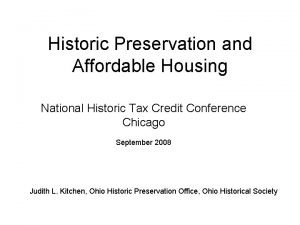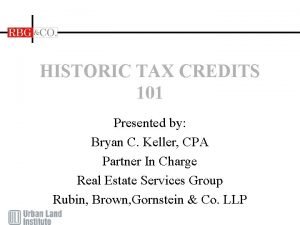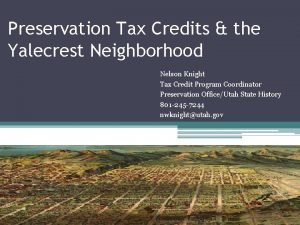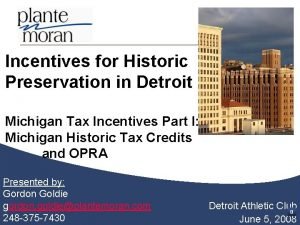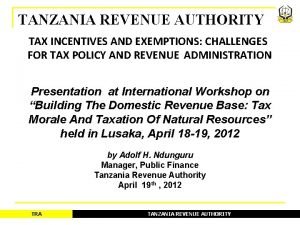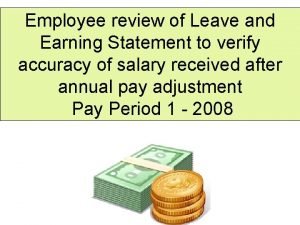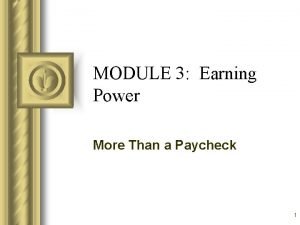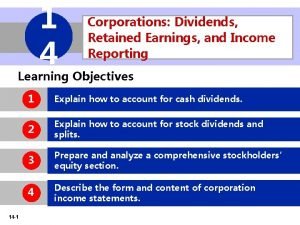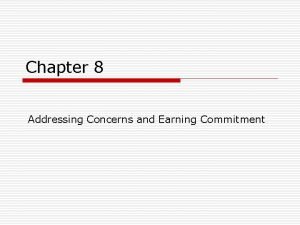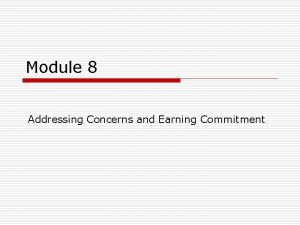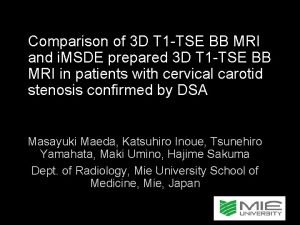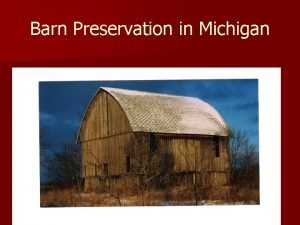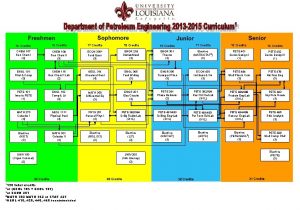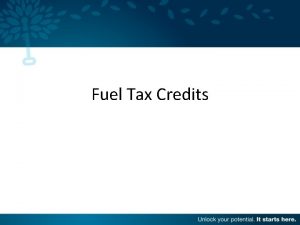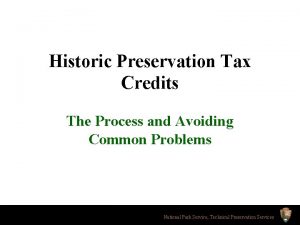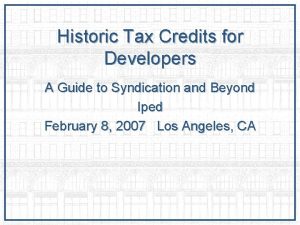Earning Historic Tax Credits The Tax Fundamentals Incentives





























- Slides: 29

Earning Historic Tax Credits The Tax Fundamentals Incentives for Historic Preservation in Detroit June 5, 2008 Detroit Athletic Club

Key Federal Tax Incentives • Rehabilitation Tax Credit (IRC Section 47). • Low-Income Housing Tax Credit (IRC Section 42). • New Markets Tax Credit (IRC Section 45 D). • Qualified Conservation Contributions (IRC Section 170(h)).

The Rehabilitation Tax Credits Internal Revenue Code Section 47

Two Types of Rehabilitation Tax Credits • Older (pre-1936), non-historic and non-residential buildings: 10 percent of qualified rehabilitated expenditures. • Historic buildings: 20 percent of qualified rehabilitation expenditures.

Important Dates in the History of the Rehabilitation Tax Credits • 1976: First federal tax incentives for historic preservation (accelerated depreciation/ amortization). • 1978: First federal tax credit for rehab of historic buildings (10%). • 1981: Three tiered tax credit (25%, 20% and 15%), including first credit for rehab of older, non-historic buildings. • 1986: Current two tiered structure; passive loss limitations imposed.

The 20% Rehabilitation Tax Credit Fundamentals • Tax Aspects Administered by the IRS. • Preservation aspects jointly administered by NPS and State Historic Pres. Offices (SHPOs). • Tax Credits = dollar for dollar reduction in tax liability (contrast with deduction). • RTC is the most important (in dollar volume) federal preservation program.

The 20% Rehabilitation Tax Credit Statistics • 1, 045 proposed projects approved by NPS in 2007. • In 2007, 45% of HTC projects were for multi-family housing; 21% for office; 27% for commercial; 7% mixed use/other • Top states ranked by Part 3 approvals: MO (189), OH (115), VA (89), NC (51), (FY 2007 statistics). • MI tied LA ranking 8 th with 27 certified projects (Part 3 approvals issued in FY 2007) • Average Cost of Projects Certified nationwide in 2007: $4. 16 million, producing on average $832, 000 in credits. Average cost of Michigan projects certified in 2007: $2, 545, 993 producing on average $509, 199 in credits



What Types of Buildings Qualify? The IRS Rules: Depreciable Building Requirement • Must be a “building”. Building is defined as a structure or edifice enclosing a space within its wall and usually covered by a roof. • Building must be depreciable. Depreciable buildings are generally those used for nonresidential (i. e. commercial) or residential rental purposes. (See Section 168(e))

What Types of Buildings Qualify? The NPS Rules: Certified Historic Structure Requirement Option #1 Building is listed in the National Register of Historic Places.

What Types of Buildings Qualify? The NPS Rules: Certified Historic Structure Requirement Option #2 Building is located in a registered historic district and certified by the Sec. of the Interior as being of historic significance to the district.

What Types of Rehabilitations Qualify? The IRS Rules: Substantial Rehabilitation Requirement The QREs incurred during any 24 -month period** selected by the taxpayer and ending in the taxable year in which the building is placed in service must exceed the greater of: – $5, 000, or – The adjusted basis of the building. **A 60 -month period may be used where written plans completed before the rehab begins show that the rehab is expected to take place in phases and is reasonably expected to take more than 24 months.

What Types of Rehabilitations Qualify? Definition of QREs • “Qualified Rehabilitation Expenditures” (QREs) is the tax term given to those development costs on which rehabilitation tax credits can be claimed. • QREs are any amounts chargeable to a capital account made in connection with the renovation, restoration or reconstruction of a qualified rehabilitated building (including its structural components), except as provided by law.

What Types of Rehabilitations Qualify? Definition of QREs include costs related to: • walls, partitions, floors, ceilings; • permanent coverings such as paneling or tiling; • windows and doors; • air conditioning or heating systems, plumbing and plumbing fixtures; • chimneys, stairs, elevators, sprinkling systems, fire escapes;

What Types of Rehabilitations Qualify? Definition of QREs (cont’d) QREs include costs related to: • construction period interest and taxes; • architect fees, engineering fees, construction management costs; • reasonable developer fees

What Types of Rehabilitations Qualify? Definition of QREs Costs EXCLUDED from QREs: – Land building acquisition; – Enlargements that expand total volume (cf. remodeling that increases FMR); – Personal property (furniture and appliances, cabinets and movable partitions, tacked carpeting); – New building construction; – Sitework (demolition, fencing, parking lots, sidewalks, landscaping)

The 20% Rehabilitation Tax Credit Calculating the Allowable Credit • Credit equals 20% of all QREs incurred: – Prior to the start of the 24 -month period selected (so long as they were incurred “in connection with” the rehab process that resulted in the substantial rehabilitation of the building); – During the 24 -month period; and – After the last day of the 24 -month period but before the last day of the tax year in which the measuring period ends.

The 20% Rehabilitation Tax Credit When is the Credit Allowed? • Credit is generally allowed in the year in which the building is placed in service (provided substantial rehabilitation test has been met). • “Placement in Service” means that the all or identifiable portions of the building is placed in a condition or state of readiness and availability for a specifically assigned function. • Progress Expenditure Election available for properties with a “normal” construction period of 2 years or more

The 20% Rehabilitation Tax Credit Recapture • Credit previously allowed is recaptured if any portion of the project which includes QREs is disposed of prior to the fifth anniversary of placement in service. • Amount subject to recapture decreases by 20% during each year of the five year period.

The 20% Rehabilitation Tax Credit Recapture • Disposition includes any sale, exchange, transfer, gift or casualty. Subsequent rehabs that do not comply with the Secretary’s Standards can trigger recapture. • Reduction of a partners interest can be deemed a disposition (33% rule).

Single Entity Structure Tax Credit Investor LLC Managing Member (Developer Affiliate). 01% Credits, Profits & Losses, Fees and Cash Flow Developer Equity Historic Tax Credit Equity 99. 99% Credits, Profits & Losses and Cash Flow Tax Credit, LLC (Property Owner) Loan Proceeds Debt Service Payments Construction/ Perm Lender Tax Credit Investor Dev. Fee Rental Payments Tenants Developer

Historic Tax Credit Syndication The Credit Pass-Through Structure • Landlord LLC owns fee simple, undertakes rehab, enters into Dev. Agreement, and earns the Historic Tax Credit. • Master Tenant, LLC leases the entire project from the Landlord LLC for a fixed annual rental payment.

Historic Tax Credit Syndication The Credit Pass-Through Structure • Master Tenant, LLC operates the property, subleases to end users and enters into the Property Management Contract. • Landlord makes special tax election to pass the Historic Tax Credit through to the Master Tenant LLC.

Master Lease/Credit Pass-Through Structure Managing Member (Developer Affiliate) Developer Equity 99. 99% Credits, Profits & Losses, Fees and Cash Flow Landlord, LLC (Property Owner/Lessor) . 01% Credits, Profits & Losses, Fees and Cash Flow Pass-through of Historic Tax Credits & Share of Residual Lease Payment & Tax Credit Investor LLC Historic Tax Credit Equity 99. 99% Credits, Profits & Losses, and Cash Flow Master Tenant, LLC (Master Tenant) Equity Investment Loan Proceeds Debt Service Payments Construction/ Perm Lender Rental Payments Sub-Tenants/ End Users

Sample Sources and Uses

Sample Transaction Calculating the HTC Equity Qualified Rehab Expenditures Credit Rate Total Calculated Credit Tax Credit Investor Allocation Total Credit to Investors Credit Price Per Each $1 of Credit Equity Contributions by Investors 24, 060, 799 20. 00% 4, 812, 160 99. 99% 4, 811, 679 0. 98 4, 727, 474

More Information? David F. Schon, Esq. dschon@nixonpeabody. com Andrew S. Potts, Esq. apotts@nixonpeabody. com

 Historic tax credits 101
Historic tax credits 101 Historic tax credits 101
Historic tax credits 101 New markets tax credit 101
New markets tax credit 101 Michigan historic preservation tax credit
Michigan historic preservation tax credit Historic tax credit syndication
Historic tax credit syndication Utah historic preservation tax credit
Utah historic preservation tax credit Historic tax credit structure diagram
Historic tax credit structure diagram Michigan historic tax credit
Michigan historic tax credit Charlie werhane
Charlie werhane New market tax credits 101
New market tax credits 101 Tax incentives in tanzania
Tax incentives in tanzania What is earning and leave statement
What is earning and leave statement Personal finance unit 1
Personal finance unit 1 Module 3 earning power
Module 3 earning power Retained earnings statement
Retained earnings statement Addressing concerns and earning commitment
Addressing concerns and earning commitment Insurable value adalah
Insurable value adalah Insider trading adalah
Insider trading adalah Expand earning potential for associates
Expand earning potential for associates Convert spending into earning logo
Convert spending into earning logo Contoh soal asuransi terhadap kerugian tidak langsung
Contoh soal asuransi terhadap kerugian tidak langsung Addressing concerns and earning commitment
Addressing concerns and earning commitment Blackberry stock price cad
Blackberry stock price cad Pus l
Pus l Deep earning
Deep earning Historic premillennialism chart
Historic premillennialism chart Trent-severn waterway national historic site
Trent-severn waterway national historic site Historic sullivan barn battle creek mi
Historic sullivan barn battle creek mi Noucentisme context historic
Noucentisme context historic Elegies de la represa vi
Elegies de la represa vi
